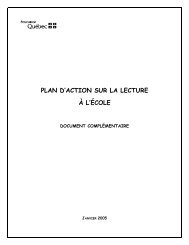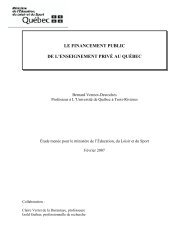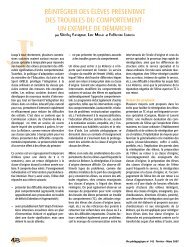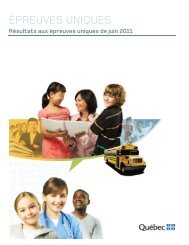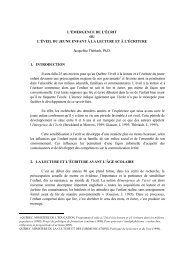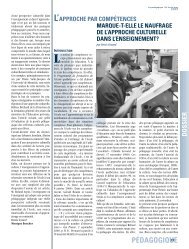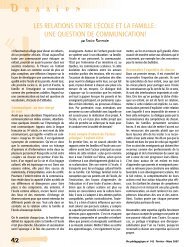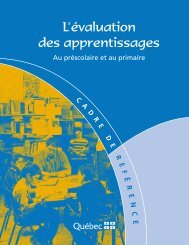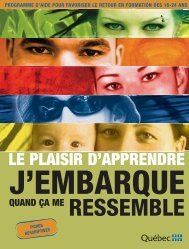Programme de formation de l'école québécoise - Ministère de l ...
Programme de formation de l'école québécoise - Ministère de l ...
Programme de formation de l'école québécoise - Ministère de l ...
Create successful ePaper yourself
Turn your PDF publications into a flip-book with our unique Google optimized e-Paper software.
ME A N I N G O F T H E CO M P E T E N C Y<br />
This competency enables elementary stu<strong>de</strong>nts to<br />
a p p r o a c h , explore and make use of various types of texts<br />
( p o p u l a r, l i t e r a r y, in<strong>formation</strong>-based) in a dynamic wa y.<br />
They <strong>de</strong>velop appropriate strategies for effective listening<br />
and reading; they learn how to <strong>de</strong>rive meaning from oral<br />
and written texts (interaction of learner and text); a n d<br />
they show their un<strong>de</strong>rstanding in meaningful tasks (minib<br />
o o k , b o o k m a r k , s ke t c h , p o s t e r, e t c . ) . This competency is<br />
a valuable means for stu<strong>de</strong>nts to discover English-language<br />
culture as they familiarize themselves with a<br />
variety of cultural products. In doing so, stu<strong>de</strong>nts make<br />
use of various media (books, b r o c h u r e s, m a g a z i n e s,<br />
v i d e o s, educational TV shows, a u d i o c a s s e t t e s, C D - R O M s,<br />
s o f t wa r e, Internet sites, etc.) as sources of in<strong>formation</strong>,<br />
entertainment and pleasure.<br />
CO N N E C T I O N S TO CR O S S- CU R R I C U L A R CO M P E T E N C I E S<br />
To reinvest un<strong>de</strong>rstanding of oral and written texts, s t u<strong>de</strong>nts<br />
need to i<strong>de</strong>ntify key elements and to distinguish<br />
between relevant and irrelevant in<strong>formation</strong>, thus drawing<br />
upon the cross-curricular competency To use infor -<br />
m a t i o n. As stu<strong>de</strong>nts reinvest their un<strong>de</strong>rstanding in tasks,<br />
they need to plan the steps that will lead to the fulfillment<br />
of tasks, thus contributing to the <strong>de</strong>velopment of<br />
Domaine <strong>de</strong>s langues<br />
COMPETENCY 2 • TO R E I N V E S T U N D E R S TA N D I N G O F O R A L A N D W R I T T E N T E X T S<br />
Focus of the Competency<br />
the cross-curricular competency To use effective work<br />
m e t h o d s. Depending on the task to be performed, s t u<strong>de</strong>nts<br />
may use ICTs, thus leading to the cross-curricular<br />
c o m p e t e n c y To use In<strong>formation</strong> and Communications<br />
T e c h n o l o g i e s.<br />
CO N T E X T S F O R LE A R N I N G<br />
The learning contexts for this competency require:<br />
– various types of texts containing redundant elements:<br />
- simple and extensively illustrated (Cycle Tw o )<br />
- of appropriate complexity and illustrated (Cycle<br />
Th r e e )<br />
– themes that are familiar and interesting<br />
– themes that meet the stu<strong>de</strong>nts’ need for in<strong>formation</strong><br />
and entertainment (Cycle Th r e e )<br />
– opportunities to <strong>de</strong>velop appropriate compensatory<br />
and learning strategies through use<br />
– opportunities to interact with peers and the teacher<br />
– a vailability of resources (visual, linguistic and media)<br />
– help from the teacher and peers<br />
English as a Second Language 356<br />
DE V E L O P M E N TA L PR O F I L E<br />
To <strong>de</strong>velop this competency, stu<strong>de</strong>nts prepare to listen to<br />
and read texts using strategies, <strong>de</strong>monstrate un<strong>de</strong>rstanding<br />
of oral and written texts using strategies, and carry<br />
out meaningful tasks using strategies. This process calls<br />
on their creativity, initiative and active participation. A t<br />
f i r s t , stu<strong>de</strong>nts are closely gui<strong>de</strong>d by the teacher. W h e n<br />
they prepare to listen to and read texts, stu<strong>de</strong>nts use their<br />
prior knowledge, contextual cues (title, s u b t i t l e s, i l l u s t r at<br />
i o n s, table of contents, s y n o p s i s, etc.) and make predictions<br />
about the content of texts. To <strong>de</strong>monstrate un<strong>de</strong>rstanding<br />
of oral and written texts, stu<strong>de</strong>nts i<strong>de</strong>ntify ke y<br />
e l e m e n t s, show their un<strong>de</strong>rstanding of the overall meani<br />
n g , compare reality presented in texts with their own<br />
r e a l i t y, and express their appreciation of texts. When stu<strong>de</strong>nts<br />
carry out tasks in which they reinvest their un<strong>de</strong>rs<br />
t a n d i n g , they plan how to do it and use texts as sources<br />
of i<strong>de</strong>as and in<strong>formation</strong>. As they progress through the<br />
c y c l e s, the level of complexity of the text is adjusted<br />
according to the cognitive and linguistic <strong>de</strong>velopment of<br />
the learner. Stu<strong>de</strong>nts become more autonomous; t h e y<br />
seek help from their peers and not as often from the<br />
t e a c h e r.




